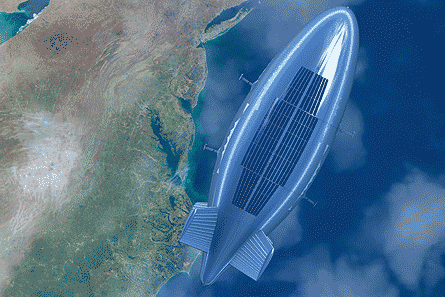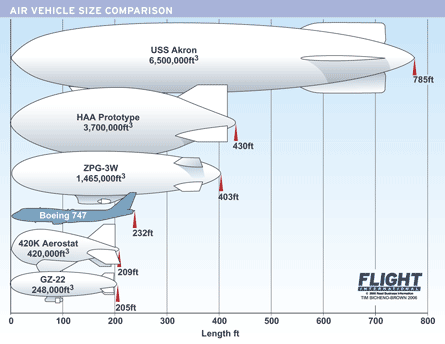By Graham Warwick in Washington, DC
Lighter-than-air craft are attracting renewed interest as a low-cost means to maintain persistent surveillance. Is technology ready for the next step?
Hydrogen-fuelled unmanned aircraft able to stay aloft for weeks, satellites that can be launched on demand within hours - an insatiable appetite for information is leading military forces and security agencies to look at new ways to maintain constant surveillance of war zones and national borders.
Some not-so-new ideas are also getting a fresh look. Interest in lighter-than-air (LTA) craft has waxed and waned over the years, but airships are again being eyed as an economic way to maintain surveillance over wide areas for extended periods.
 |
|---|
| DARPA's ISIS embeds radar arrays in the hull material |
"Persistence is in the top five of commbat commanders' requirements," says Ron Browning, business development director for Lockheed Martin's high-altitude airship programme. "Persistence can mean different things to different users - to us it means always there, always on."
Although the US military has not flown airships for decades, a significant and growing number of tethered aerostats are being used for force protection and border monitoring, and larger systems are in development as elevated sensors for cruise-missile defence.
The use of airships for extended surveillance has been held back by the difficulties of ground handling and limits on operating in poor weather. Now technology offers a way to overcome those disadvantages by enabling unmanned airships that can climb into the stratosphere, above the winds, and stay on station for months, even years.
"With geopositioning we can provide constant surveillance of the same geographic area," says Browning. Looking down from 60,000-65,000ft (18,000-20,000m), the lower edge of what the US Air Force calls "near space", an airship can view an area exceeding 800,000km2 (308,880miles2). "That's bigger than Iraq or Afghanistan. We can cover a whole country."
Stratospheric surveillance airships have yet to advance beyond the design stage, but two programmes are leading development of the required technologies: the US Missile Defense Agency's High Altitude Airship (HAA) prototype and the Defense Advanced Research Projects Agency's (DARPA) Integrated Sensor as Structure (ISIS) demonstration.
The HAA programme aims to fly a subscale airship in 2010 to demonstrate the ability to stay on station in the stratosphere for 30 days. Funding permitting, a full-size operational airship could follow within two years, says Lockheed. ISIS is a sensor, not a platform, programme, but is aimed at demonstrating technology for a next-generation airship that could enter service in 2018.
 |
|---|
| The HAA prototype will use solar cells by day, batteries by night |
Nearer term, and underlining the growing interest in unmanned airships, the US Department of Homeland Security plans to demonstrate next year an untethered lighter-than-air platform able to operate above 18,000ft for at least 24h, to be used for border surveillance. This would use current airship and sensor technology, but could pave the way for operational use of unmanned airships for extended surveillance.
A major advantage of airships for persistent surveillance is their low cost compared with unmanned air vehicles or satellites, says Browning. Using cost per payload pound per hour as the metric, Lockheed estimates that satellites cost $1,000-4,000, UAVs $300-1,000 and the HAA just $2-5. "It's hard to get it out of single digits. The airship provides a significant advantage for the persistent mission," he says.
Sweet spot
The HAA is a nonrigid airship, or blimp - its shape maintained by the internal pressure of the helium lifting gas - and is designed to operate at 65,000ft where the winds are lowest, requiring the least power to maintain station. "There is a sweet spot in the winds at 60,000-70,000ft, which allows the size of the airship to be kept to a minimum," Browning says. Once on station at that altitude the solar-powered vehicle will also be well above controlled airspace.
An operational HAA would be around 150m (500ft) long with a 140,000- 170,000 m3 (5-6 million ft3) envelope, carrying a 900kg (2,000lb) sensor payload and with the energy accumulation and storage capacity for at least six months endurance. The all-electric vehicle would need 10-20kW of power, says Browning, using solar cells for collection and batteries or fuel cells for storage. "Endurance is set by the loss of helium and decline in solar efficiency over time," says Browning.
The HAA prototype, which Lockheed Martin Maritime Systems & Sensors in Akron, Ohio is building under a $149 million contract awarded in December, is a 131m-long, 120,000m3 vehicle carrying a 150kg payload and generating 3kW of solar power, using lithium batteries for storage. The goal is to stay on station for 30 days, to demonstrate the ability to maintain power though the diurnal cycle.
"No one has flown an LTA to 60,000ft and stayed there," says Browning. "HAA is designed to stay at altitude most of its life." The prototype will be flown from Akron and controlled via line-of-sight link, but an operational HAA could deploy from the USA, or a regional base, and be controlled via beyond-line-of-sight satellite communications link.
While the HAA faces funding challenges that could delay the prototype's flight, DARPA is moving ahead with its ISIS programme to develop technology for the next generation of stratospheric surveillance airship. A series of contracts have been awarded for the two-year, $40 million second phase to develop critical technologies and refine the operational system designs.
"This is a sensors programme," says DARPA programme manager Tim Clark. "The goal of ISIS is tactical-grade tracking of the hardest air and ground targets: low-flying, slow cruise missiles in clutter and dismounted soldiers and slow vehicles." Again the attraction of the airship as a platform is its economics. "We see an order of magnitude reduction in cost, and improvement in performance, versus existing or near-term intelligence, surveillance and reconnaissance platforms."
The ISIS programme envisages a large nonrigid airship with a dual UHF/X-band active-array radar providing simultaneous airborne and ground moving-target indication (AMTI/GMTI). From 70,000ft, the airship would track thousands of air targets out to the radar horizon at 600km, while tracking ground vehicles, both in the open and behind trees, out to 300km. A regenerative fuel-cell power system would allow the unmanned airship to deploy from the USA and stay aloft for at least year with 99% on-station availability, regardless of the environment.
|
|---|
| ISIS is looking at lenticular airships with very large array areas (top) as well as conventional, if large blimps (bottom) |
 |
Radar performance is a function of power and aperture, and a massive, flexible, active electronically scanned array (AESA) bonded to the airship's hull material provides a very large aperture. "Real estate has always been the issue, so previous investment has been in increasing radar power, to the point where we have to fill the aircraft with cryo-cooling to prevent the nose melting off," says Clark. "As the aperture gets larger, power density reduces and so does cooling."
ISIS is intended to overcome the severe limitation on payload mass that affects conventional airships like the HAA, where payload is just 1.7% of available lift. "If we use pressure to get stiffness, and put the aperture into the hull material, we can get the payload mass up to 30-40% of the total," says Clark. "ISIS is really about driving down mass, as lifting gas has reached its limit, so the focus is on the integration of sensor and structure - on bonding together the hull material, active aperture and solar cells."
Weight critical
Phase 2 of the programme is focused on developing technology in four key areas. As the heaviest piece of the airship is its hull, DARPA has set a goal of reducing material density from today's 400g/m2 to 100g/m2 or less, while maintaining strength and resisting creep over the airship's five-year design life. The aperture is the second heaviest piece, and the programme aims to develop a low power-density AESA weighing 2kg/m2, down from today's 20kg/m2 for a flexible array.
Bonded to the hull material, the flexible AESA will move along with the airship's envelope. "We can't afford to stiffen the structure. Movement of the skin will transfer into the AESA, and move across the array, so we need to be able to calibrate it electronically," says Clark. "It's okay to have the array move as long as we can predict where and how it will move and compensate."
The radar array will be made up of "several million" transmit/receive modules, says Clark, and the cost goal is less than $5 per module. "The cellphone industry is the driver, as the technologies are not significantly different," he says. Power consumption is not a principal concern, he says, because the array's low power-density means the highest consumption is on the receive, not transmit, side of the radar, to keep the low-noise amplifiers warm.
But ISIS aims to develop the first fully regenerative power system for a long-endurance stratospheric airship. The all-electric airship is expected to draw a steady 100kWh in nominal winds, peaking at 1MWh as it works to maintain station during the three to five days of seasonal high winds experienced in the northern hemisphere. The weight of the power system is critical. "If we used batteries, we could not lift them," says Clark. "We need a lightweight, fully regenerative power system." The ISIS goal is a 400Wh/kg night-time power-to-weight ratio, with a technology path to 800Wh/kg, he says.

Results from the technology development contrast will be provided to two system contractors - Lockheed Martin Skunk Works and Northrop Grumman Electronic Systems - who will use the data to refine their designs for an operational system. A programme review is planned for late 2007/early 2008 that will result in a go/no-go decision to build a one-third scale demonstrator, with an aperture of at least 50m2, which could fly for several months beginning in late 2010. An operational vehicle could be ready by 2018.
Clark says the missions for such a vehicle have yet to be defined. "It all driven by the fact it's a sensor problem. Once we solve that, and take all the issues off the table, the question is do the services want to buy it?" But he believes a stratospheric airship is the ideal MTI platform, the resolution provided by the very large aperture ensuring that if a target can be detected, it can be tracked. "Persistent MTI is very valuable," he says.
Source: Flight International














